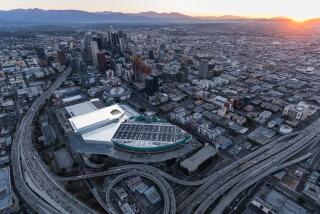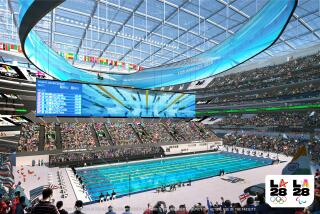Struiksma Urges Rebidding to Trim Cost Projection for Convention Center
- Share via
Saying that a projected $20-million cost increase for San Diego’s waterfront convention center “demands prudence, not haste,” acting Mayor Ed Struiksma on Saturday called for the project to be rebid.
Rebidding will both reduce the center’s price and “ultimately leave us with a better building,” Struiksma said.
Although rebidding likely would cause at least a four-month delay for a project already six months behind schedule, Struiksma called the possibility of a further delay “a relatively small, temporary price to pay for the comfort of knowing that we’re doing this thing right.”
“I realize this is going to cost us some revenue from convention business, and that’s unfortunate,” Struiksma said. “But given the complexity of this project and some of the confusion surrounding the bids, I think rebidding makes much more sense than rushing forward.”
A task force established by Struiksma last month in the wake of construction bids coming in more than $22 million over budget is scheduled to meet Wednesday to recommend whether the San Diego Unified Port District should immediately proceed with the project or rebid it in an attempt to cut costs.
Last week, two subcommittees presented the task force with diametrically opposed recommendations--one urging that the convention center be built immediately despite the cost increase, while the other panel proposed that the project be rebid in an attempt to reduce construction expenses.
A group of architectural and construction experts told the task force that rebidding the project could save nearly $10 million, but local tourism officials countered by emphasizing that the resulting delay in construction could cause the loss of that much--or more--in convention business.
Noting that the task force was “a somewhat divided house” at its last meeting, Struiksma conceded that he is uncertain whether the group will endorse his recommendation at this week’s meeting. The final decision on whether to accept one of last month’s bids or solicit new ones rests with the port district, which will finance construction of the 1.4-million-square-foot structure on Navy Field, adjacent to Seaport Village and the Hotel InterContinental.
“You can make a pretty strong case for going either way,” Struiksma said. “From my vantage point, though, we gain more than we lose by rebidding. The most important thing is that it gives us the time to make sure we’re not making a mistake or locking ourselves into something we’re going to regret for many, many years just for the sake of trying to save a few months.”
During last week’s task force debate, architect Paul Buss said that rebidding the project would produce about a four-month delay. However, because excavation of the site, originally supposed to be completed last October, is not expected to be finished until mid-June due to water drainage problems, the practical delay could be only about two months, Buss added.
However, the task force members who favor immediately proceeding with the project expressed skepticism that the delay would be as short as Buss’ projection. Struiksma, though, argued that rebidding “still would be the best and most prudent course” even if the delay eventually proved to be longer.
Length of Delay
“I wouldn’t be overly concerned if it stretched out to 4 1/2 or five months, or perhaps a bit longer,” Struiksma said. “I really don’t think the delay would go much longer than that. Anyway, we don’t know for sure that the excavation is finally going to be done in June, so maybe the delay will be shorter than we think.”
If the project is rebid, Struiksma added, he also believes that a construction manager should be hired to serve as a liaison between the port and the city and to “keep the project moving along smoothly” once construction does begin.
“That’s the critical point where you don’t want any additional delays,” Struiksma said.
The controversy over the convention center’s rising costs was touched off last month by the port’s receipt of six construction bids ranging from $123.9 million to $133.7 million--more than 20% above the port’s $101.5-million budget for construction of the Navy Field structure. Port Commissioner William Rick has explained that excavation, utilities, furnishings and other costs could push the center’s final cost to nearly $160 million--$65 million more than the $95-million price tag often cited by proponents in the November, 1983, campaign in which San Diegans approved the project in an advisory vote.
Architect Buss told the task force last week that the construction costs could be cut by about $10 million through rebidding, largely because a second round of rebidding would occur in a “considerably less chaotic atmosphere.”
Because of numerous design changes that occurred during the final stages of last month’s bid process, the firms that bid may have inflated their figures as a safeguard against unexpected expenses, some task force members argued.
Construction Timetable
Costs could be cut further by lengthening the proposed construction timetable from the present 26 months to 30 months, which would reduce the need for labor overtime expenses. Struiksma said Saturday, however, that he would not favor the longer construction period “unless the cost savings are really significant.”
While conceding that rebidding would lower costs, local tourism officials have warned the task force that any potential construction savings could be offset by the loss of convention business likely to result from any delay in the center’s planned August, 1988, opening.
Nearly $25 million in convention business already has been booked for the facility’s first year, and some of that money “would be in serious jeopardy” if the center’s opening is pushed back, according to Jim Granby, president of the convention center’s board of directors.
By forcing possible cancellation of some conventions, a further delay also could produce at least a one-time reduction in the estimated $190 million in annual visitor spending and $10 million in yearly city tax revenues that the center is expected to generate.
“We’d lose a little money up front, but I think that by taking a little extra time now, we’re going to end up with a much better overall product that will (recoup) that money and then some in the long run,” Struiksma concluded.
More to Read
Sign up for Essential California
The most important California stories and recommendations in your inbox every morning.
You may occasionally receive promotional content from the Los Angeles Times.










